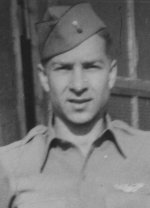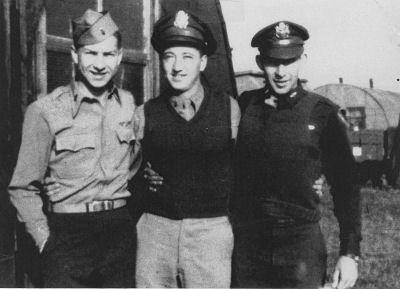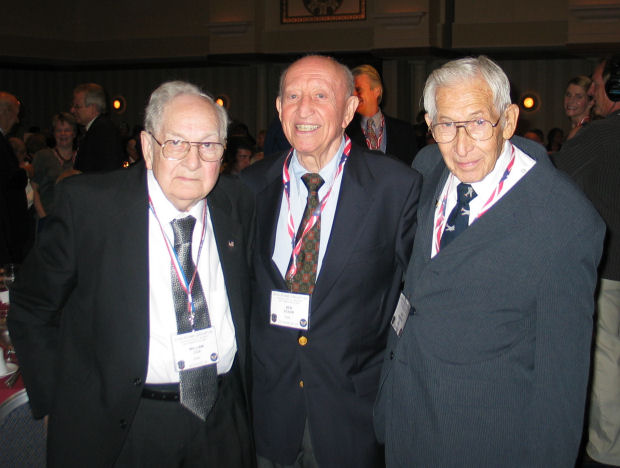 |
358th Cox Crew William H. Cox, Pilot |
Personnel
Mission Reports

WILLIAM H. COX - 358th BS
(Lt. Cox assigned 358BS: 17 Aug 1944 as CoPilot on 1Lt Grisham Crew)
(upgraded to Pilot 04 Dec 1944)
1Lt William H. Cox (P) - 1Lt Cox had no assigned crew. He flew most of his missions as CoPilot on the 1Lt Rufus W. Grisham Crew.
Notes:
1Lt Cox flew on 36 dispatched (35 credited missions):
- As CoPilot: With 1Lt Rufus W. Grisham, Jr. (P) - 28 credited missions (235, 238, 240, 245, 249, 250(A), 252, 255, 257, 258, 259, 260, 262, 264, 270, 271, 272, 274, 276, 279, 280, 281, 294, 295, 296, 297, 298A, 298B); With other Pilots on 1 mission each 2Lt Marvin W. Heckendorf (P) - (268);
2Lt Werner G. Goering (277); 1Lt Jack P. Rencher (286); 2Lt William H. McLeod (292),
Unknown Pilot - As a new crew combat orientation CoPilot (288). As Tail Gunner Observer with
1Lt Campbell Miller (P) - (290).
- Upgraded from CoPilot to Pilot, effective 4 Dec 1944, on 303rd Operations Order #83, dated 5 Dec
1944. Flew one mission as First Pilot with an unknown Pilot and crew (289).
For Mission dates, targets and Mission Reports, see Combat Missions.
- William H. Cox remained in the Air Force following WWII and retired as an Air Force Colonel. He has served the 303rd BGA as Treasurer and President and has assisted a number of 303rd BG(H) members in obtaining deserved and overlooked DFC and other awards as our WWII Awards Chairman. Please see William H. Cox's biography.

Bill Cox, Ben Starr and Jack Rencher (Molesworth 1944)

Bill Cox, Ben Starr and Jack Rencher (1944 photo recreated in Washington DC, 2007)
of the Winter of 1944 - by William H. Cox
If anyone has ever spent any time in the Midlands of England during a winter, they understand the need for keeping out of the damp chill which quickly invades the body. It was during the winter of 1944, the chill seemed even colder than ever, especially living in a Quonset hut (fondly referred to as "Rambler’s Roost”) which had only one coal stove for furnishing heat. To make matters worse, rationing limited the supply of coal to one shovelful per person per week.
The nine other officers of the 358 BS and I soon discovered that It was necessary to add to our meager supply of coal in order to avoid the constant misery of the cold. Since it was our job to be familiar with the military style of executing an air operation, it was only natural for us to devise a military style of executing a ground operation for successfully obtaining the badly needed coal. The source of our needs was a huge, well secured coal pile, located on our airbase at Molesworth. Using our combat experience, we determined that there were four main steps for our mission: the reconnaissance phase, the planning phase, the briefing phase, and the execution.
The reconnaissance phase consisted of sending, out two officers on their bicycles during the day to survey the large coal pile. Their assignment was to bring back the fact about its location, roads and paths nearby, the number and location of security guards in the area, and the places in the fence where coal might already be spilling out at the bottom. They accomplished their task in an outstanding manner. Our two spies located a weak spot. in the fence where coal was flowing out from underneath, far from the guard’s post. They also reported that the one guard spent the majority of his time at his post, both day and night. Armed with this knowledge, our target and aiming point were located for the upcoming mission. The next phase was to have our best planners draw up the plan of attack, now they had all the necessary required information. The planning phase was critical, for the success or failure of a military mission rests on a good sound plan. After several hours the planners had all the requirements written out and in the proper format. A "fighter force" of three men would "fly cover" for our main raiding force. The main raiding force consisted of six men. The fighter force’s task was not to attack the enemy, but to quickly warn the main force in the event it became necessary for a fast 180 degree turn and quick withdrawal. The main force was to use three wheelbarrows, left each evening by English workmen, who were working on a construction project next to our Quonset hut. A pilot was assigned to "fly" each wheelbarrow, in single trail formation, at five minute intervals into the target area. Each wheelbarrow would also have a copilot armed with a shovel for use only on the target.
The plan further called for a night attack, since the English wartime blackout was already an excellent cover. A half moonlit night was selected to give a small amount of light which seemed necessary for the task at hand. A ground recovery group was also required. It would be their job, once the main force returned to home base, to assist in quickly dumping the captive coal into many small boxes located under our beds. The fighter force was to double as the ground recovery force, for they would return on the withdrawal well ahead of the main task force. The route both in and out of the target area was carefully selected after studying the available roads and paths to our living quarters and the coal pile. The shortest and most direct route was chosen for the least amount of exposure time to "flak.”
To avoid any tip-offs of the operation, there were no dry runs scheduled. The plan was designed for our side to offer no opposition if once discovered. The recall phrase was, "Run like hell if about to be caught."
Once the plan was finished, it was necessary to conduct a briefing. To ensure no mistakes during the operation, a formal briefing was conducted in the Quonset hut – the complete plan was briefed in detail. A specialized briefing followed and each member went into great detail on their particular part of the effort. Detailed timing was covered, abort procedures in the event the mission might be recalled, and of course, a time back was given. Even procedures in event of capture were briefed. Each crew member was reminded to give only his name, rank, and serial number.
After the briefings, the implementation order was given and the operational phase, began on time. All sorties made good their briefed takeoff time. The mission went extremely well. There was no “flak" from the enemy en route, nor any in the target area. All sorties reached the target at the briefed time and the target was hit as briefed. By lifting the bottom of the fence near the ground, the coal poured fourth and the teams quickly shoveled it into the wheelbarrows. Each crew made a silent withdrawal and the enemy security guard never knew what had happened. The route home was flown as briefed and no problems were encountered. After the loads of coal arrived safely back at home base, they were unloaded as briefed. A strike report was prepared to be sent on to higher headquarters. However, it was never sent. Success is one thing, but to let our higher officers know about this caper would have been going a little too far. A de-briefing was conducted shortly after all the forces had unloaded and secured their wheelbarrows back in their normal parking stubs. The de-briefing consisted of bringing out bottles of Scotch whiskey and each man telling his personal story of the attack. It soon turned into a victory celebration, which I remember as lasting well into the late hours. It was a good feeling to know that our prefabricated shelter of corrugated metal which we called home, would again be warm and livable for some time to come.
A few of the featured officers who flew in the "Coal Pile Capers"
- Lt. Rufus W. Grisham, Jr.
- Lt. Gale Hartel
- Lt. Nick J. Celich
- Lt. Jack P. Rencher
- Lt. Ben Starr
- Lt. William A. Cox